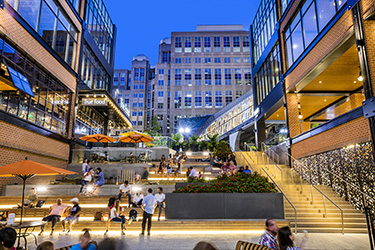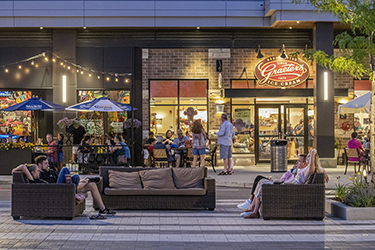|
Subscribe / Renew |
|
|
Contact Us |
|
| ► Subscribe to our Free Weekly Newsletter | |
| home | Welcome, sign in or click here to subscribe. | login |
Real Estate
| |
 |
July 30, 2020
The coming evolution of cities and public spaces
CallisonRTKL

Insel
|

Lee
|
How we live, work and play is undergoing fundamental change.
At the personal level, everyday routines have been upended. We are dealing with issues and situations that are new to us. In many cases, we are being acutely reminded of things we perhaps took for granted.
At the civic level, well, where do we even begin? Public health and safety. The economy. Transportation. The school system. The list goes on and on.
The future of cities and public spaces will bring us challenges as well as many opportunities. One big challenge will be keeping our downtown corridor vibrant as the role of the “office” undergoes dramatic evaluation. How can we make downtown appealing to the new remote workforce? We must first start by looking at how people were, and are, changing.
The coronavirus accelerated many facets of people’s attitudes and behaviors that were already in place prior to the pandemic: increased focus on self-care, enrichment and well being; self-discovery and learning; quality over quantity driving purchase decisions; and technology to keep us connected to family, our social networks and our co-workers when we can’t be there in person.
However, we are social beings and nothing will ever replace our desire and need to engage face-to-face.
Some things will gradually return to normal while others, perhaps, will not.
We do know that we will need to reimagine the typical urban experience for whatever the new normal will be, and empathy to people’s rational and emotional needs will be paramount.
Communities will win if they stay true to themselves. Be real. Be authentic. Be people-centric.
Just how might the urban environment — that we have come to know and expect — evolve? Design considerations revolve around how cities have helped create spaces for fulfillment of basic human needs: commerce, government administration, worship, and social interaction, but now there is a new baseline of expectations that needs to be addressed.
Transportation is one of the key considerations when re-imaging the future of the public realm. Cities around the world and in the U.S. are looking to car-free streets as part of the recovery. New York City has closed 40 miles of streets across the boroughs to cars to make more space for pedestrians and bicyclists.
Biking and walking are attractive in a pandemic — they’re resilient, reliable, affordable and they even allow for social distancing. Without cars, streets have more open space to be used for outdoor dining zones, pop-up events and artistic interventions. Even before the pandemic, cities like Milan, Paris and London had created car-free zones and flexible streets that were used as social spaces — not just a way to get from one place to another.
Street life will be seen as more than just retail storefronts. We often think of downtown street life as primarily a retail-centric environment, but there are other uses and services that contribute to the health and vitality of our sidewalks. Outdoor dining is a vital part of the equation, and now more than ever restaurants and bars are turning to dining outdoors to make customers feel safe.
Cities are re-evaluating their sidewalk rules and codes, so as to expand outdoor seating capacity. Artistic and creative public seating zones and clusters can provide places for respite and relaxation. Walk-up windows for food or personal services provide convenience as well as social distancing and should be considered as part of the street environment.
Curbside pick-up zones for restaurants and retail have exploded under the lockdown and will continue in our gradual re-opening.
Long before the pandemic, retailers such as Nordstrom were using curbside pickup and drop-off as a way to offer their customers convenience and flexibility. This trend will continue to increase as restaurants, bars and other personal services see the benefits for their customers. Cities will need to manage the curbside zone as pickup/drop-offs will compete with rideshare, transit stops, delivery zones and street parking.
Public spaces will also evolve. Thoughtful landscaping, art and environmental graphics can be used to help enliven public parks and plazas while providing for adequate social spacing. The city of New York painted graphic white circles in Domino Park to encourage the public to stay safely apart.
Flexibility and adaptability are also important when considering how public paces can evolve. Modular and mobile structures should be considered when planning public spaces. One example, Boxpark (in the UK) used refitted shipping containers to create “the world’s first pop-up mall, fusing the concepts of modern street food side-by-side with local and global brands,” creating a unique shopping and dining destination. Structures of this nature could be used for a wide range of programs like dining, art shows, farmers markets and public speaking events.
As we move forward, urban public spaces will be driven as much by the informal experience as the formal space. They must allow for user curation and adapt to changing consumer needs. Lively public spaces are the connective tissue that bring cities to life and make them more human.
Life under, after and beyond “the curve” is and will be change-management on steroids for all of us. But history has proven we are a resilient lot, individually and collectively. Our success, once again, will rest on our ability to adapt, adopt and evolve.
For us, the evolution is already well underway.
Joan Insel is a vice president in CallisonRTKL’s Seattle office. Her diverse background in architecture and graphic design brings a unique perspective to her projects. Michael Lee is a vice president in CallisonRTKL’s Seattle office. His expertise lies in creative placemaking and designing successful commercial environments.
Other Stories:
- Sustainable satellites: Saviors of our cities?
- Design, science and the brain
- The evolution of urban development on First Hill
- Life science thrives in urban hubs
- Bold architecture blends with nature in the city
- A radical rebalancing of the urban environment
- Landscape architecture in the time of COVID-19
- Seattle’s march toward legacy city
- Designing for a holistic community experience




